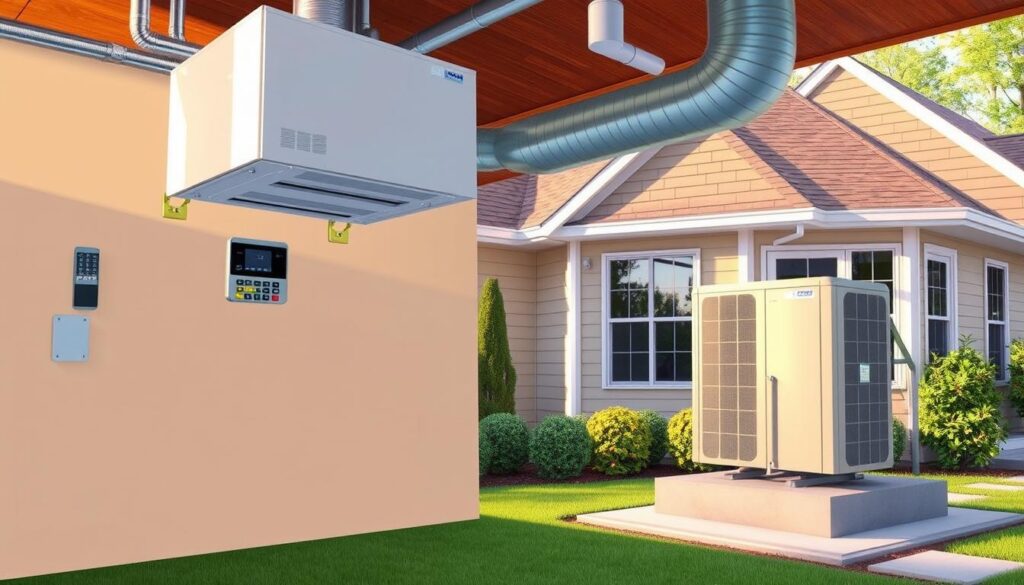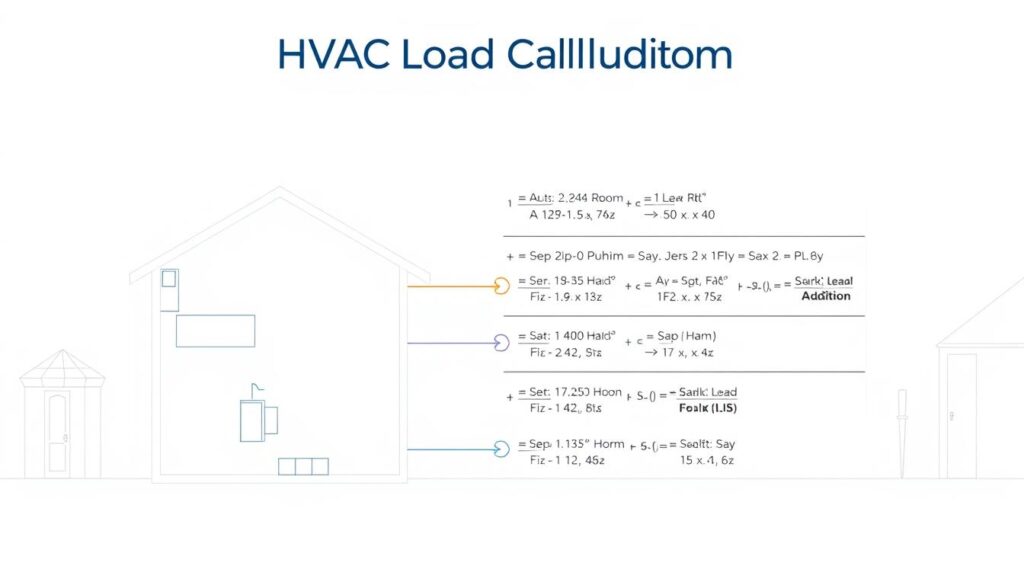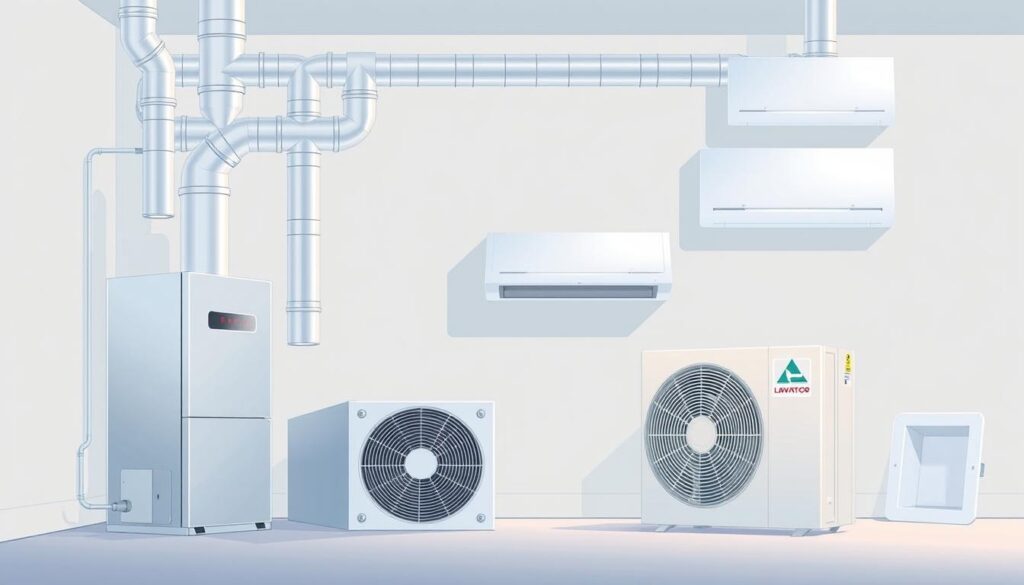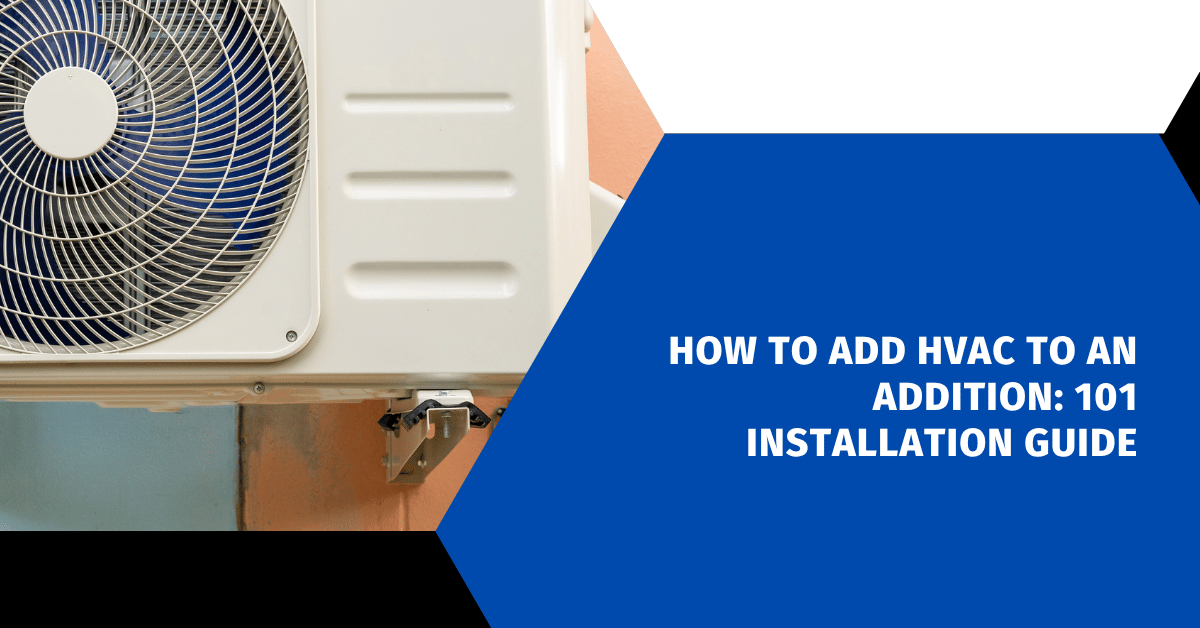Affiliate Disclosure
HVAC Guide Guys is a participant in the Amazon Services LLC Associates Program, an affiliate advertising program designed to provide a means for sites to earn advertising fees by advertising and linking to Amazon.
How to Add HVAC to an Addition? Are you thinking about adding heating and cooling to your new home addition? It’s important to plan carefully and think about your current system’s strength. This ensures your new space stays comfortable without costing too much.

Adding HVAC to your home addition is key when you’re expanding. Your new area needs to be able to control temperature well. It should work smoothly with your home’s current climate system.
This guide will show you how to add HVAC to your addition. We’ll look at various options that fit your needs, budget, and home layout.
Key Takeaways
- Understanding different HVAC options for home additions
- Evaluating existing system capacity before installation
- Exploring cost-effective heating and cooling solutions
- Considering energy efficiency in your HVAC choice
- Importance of professional assessment and installation
Table of Contents
Understanding HVAC Options for Home Additions
When you’re adding to your home, picking the right heating and cooling system is key. It’s important for comfort and saving energy. You need to think about different HVAC designs that fit your needs.
Today, there are many HVAC options for expanding your home. The best one depends on your home’s layout, current setup, and how much you want to save on energy.
Split System vs. Packaged Units
There are two main HVAC setups for home updates:
- Split Systems: These have separate indoor and outdoor parts for more flexibility
- Packaged Units: They’re all in one, making them easy to install and compact
| System Type | Pros | Cons |
|---|---|---|
| Split Systems | More efficient, quiet operation | Higher installation complexity |
| Packaged Units | Simpler installation, compact design | Lower energy efficiency |
Benefits of Different HVAC Solutions
Your HVAC choice should focus on comfort and lasting performance. Each system has its own benefits:
- Central air conditioning cools your whole home
- Ductless mini-splits control temperature in different zones
- Heat pumps are efficient for both heating and cooling
Energy Efficiency Considerations
“Investing in an energy-efficient HVAC system can reduce your long-term operational costs by up to 30%.” – Energy Star Research
When you’re growing your home, look for systems with high SEER ratings. Also, consider features like programmable thermostats. They help save energy and keep you comfortable.
Evaluating Your Existing HVAC System Capacity
Figuring out if your current HVAC system can handle an addition is key. It’s important to size your HVAC system right for new square footage. This keeps your home comfortable and prevents damage to your equipment.
When figuring out the HVAC load for additions, consider a few things:
- Total square footage of the new space
- Insulation quality of the addition
- Number of windows and doors
- Local climate conditions
- Existing system’s current capacity
An HVAC unit that’s too small can make your home uncomfortable. It might not cool or heat the new area well. This can lead to higher energy bills and damage to your system.
Professional HVAC contractors recommend a comprehensive load calculation to ensure optimal system performance.
To check if your system is up to the task, follow these steps:
- Measure the exact square footage of your addition
- Look at your current system’s BTU rating
- Get advice from a certified HVAC pro
- Find out if you need a new system or an upgrade
Pro tip: Never assume your existing system can handle additional space without professional assessment.
Explore Our HVAC Shop
Looking for top-rated HVAC tools, parts, and accessories? Visit our shop and find the perfect solution for your needs.
Visit the ShopHow to Add HVAC to an Addition
Adding HVAC to a home addition needs careful planning. It’s important to integrate it well with your current system. This ensures your new space is comfortable and energy-efficient.
When adding ductwork for room additions, you have several options. Your choice depends on your current HVAC system and the new space’s needs.
Evaluating Ductwork Extension Options
Integrating new HVAC with your existing system requires a detailed look at your setup. Here are important things to consider:
- Measure the total square footage of the addition
- Check your current system’s load capacity
- Assess the existing ductwork’s ability to handle additional airflow
Installation Techniques
Successful HVAC integration involves precise steps:
- Conduct a professional load calculation
- Inspect current ductwork for potential modifications
- Determine appropriate connection points
- Select compatible HVAC components
| Extension Method | Complexity | Cost Range |
|---|---|---|
| Direct Duct Connection | Low | $500 – $1,500 |
| Zoned System Installation | High | $2,000 – $5,000 |
| Separate HVAC Unit | Medium | $3,000 – $7,000 |
Getting professional help is key when adding ductwork for room additions. It ensures your system works well and saves energy.
Calculating HVAC Load Requirements for Added Space
When you add more space to your home, figuring out the HVAC load is key. It ensures your home stays comfortable and uses less energy. You need to consider several factors to size the HVAC system right for your new area.

Experts use a method called Manual J load calculation for this. It looks at many important things:
- Total square footage of the addition
- Insulation quality and thickness
- Window type and orientation
- Local climate conditions
- Number of occupants
- Exterior wall construction
Knowing these details helps avoid mistakes in choosing the right HVAC size. A system that’s too small won’t keep your space comfortable. On the other hand, a system that’s too big wastes energy and raises your bills.
| Calculation Factor | Impact on HVAC Load |
|---|---|
| Room Exposure | Direct sunlight increases cooling requirements |
| Ceiling Height | Taller rooms need more heating/cooling capacity |
| Insulation R-Value | Higher R-value reduces load requirements |
Pro tip: Always work with a certified HVAC professional. They can do an accurate Manual J calculation. This ensures your new addition gets the best climate control.
Explore Our HVAC Shop
Looking for top-rated HVAC tools, parts, and accessories? Visit our shop and find the perfect solution for your needs.
Visit the ShopDuctless Mini-Split Systems as Alternative Solutions
When you’re adding to your home, ductless mini-split systems are a great choice. They heat and cool your space well without needing big ducts. This makes them perfect for updating your home.
Ductless mini-split systems are popular for their flexibility. They make it easy to add HVAC to new areas of your home.
Installation Process
Installing a ductless mini-split system is easy:
- Select the best spot for the indoor unit
- Drill a small hole for the lines and connections
- Mount the indoor and outdoor units
- Connect the lines
- Test how well it works
Cost Considerations
| System Type | Average Installation Cost | Energy Efficiency |
|---|---|---|
| Single-Zone Mini-Split | $2,000 – $5,000 | Up to 30% more efficient |
| Multi-Zone Mini-Split | $5,000 – $10,000 | Up to 40% more efficient |
Maintenance Requirements
To keep your ductless mini-split system running well:
- Clean the air filters every month
- Check the refrigerant once a year
- Keep the outdoor unit clean
- Get a professional check-up every 2-3 years
Ductless mini-split systems are a smart choice for homeowners. They offer efficient and flexible HVAC for home additions.
Essential Components for Addition HVAC Installation

When you’re planning to add to your house, knowing about your HVAC system is key. HVAC experts say it’s important to design your system thoroughly.
Your home’s HVAC system has several important parts. They work together to keep your home at a comfortable temperature:
- Compressor: The heart of your cooling system that pressurizes refrigerant
- Condenser: Releases heat from the refrigerant outside your home
- Evaporator Coil: Absorbs heat from indoor air, creating cool circulation
- Air Handler: Moves conditioned air through your ductwork
- Thermostat: Controls temperature and system operation
HVAC contractors for home additions will help you pick the right parts. They’ll check your current system and suggest upgrades or additions for better performance.
Choosing the right components is crucial for comfort and energy savings in your expanded home.
When adding new HVAC parts, think about:
- System compatibility
- Energy efficiency ratings
- Home layout and insulation
- Future maintenance needs
Learning about these key components helps you make smart choices for your home’s heating and cooling.
Explore Our HVAC Shop
Looking for top-rated HVAC tools, parts, and accessories? Visit our shop and find the perfect solution for your needs.
Visit the ShopProfessional Installation Requirements and Permits
When planning hvac installation for home additions, knowing the professional needs is key. Professional HVAC contractors have the skills to make sure your home addition is safe and legal.
Dealing with hvac contractors for home additions needs careful focus on local rules and standards. Your installation must meet many requirements for safety and efficiency.
Local Building Code Considerations
Building codes differ by area, but they usually have specific HVAC rules:
- Minimum ventilation standards
- Required equipment specifications
- Electrical and structural compliance
- Zoning restrictions
Necessary Documentation
Professional HVAC contractors will guide you in getting the right documents:
- Detailed project blueprints
- Equipment specifications
- Permit application forms
- Energy efficiency calculations
Safety Regulations
| Safety Requirement | Description |
|---|---|
| Electrical Safety | Proper electrical connections and circuit load management |
| Refrigerant Handling | EPA-certified technicians required for refrigerant management |
| Structural Integrity | Ensuring HVAC installation does not compromise building structure |
Working with licensed professionals ensures your home addition’s HVAC system meets all regulatory requirements, providing peace of mind and long-term performance.
Cost Analysis and Budgeting
When planning hvac installation for home additions, you need to think about your budget carefully. Several factors will affect the total cost of your project. Knowing these helps you make smart choices about your HVAC system.
The cost for hvac contractors for home additions usually falls between $3,500 and $7,500. This includes the cost of equipment, labor, and any needed system changes for a smooth setup.
- Central AC unit cost: $2,500 – $4,500
- Installation expenses: $1,000 – $3,000
- Ductwork modifications: $500 – $1,500
Your exact costs will depend on:
- The size of your home addition
- The current state of your HVAC system
- The energy efficiency of the system
- The rates of local laborers
| System Type | Average Cost | Energy Efficiency |
|---|---|---|
| Central AC | $4,000 | 14-16 SEER |
| Ductless Mini-Split | $3,000 | 16-22 SEER |
| Heat Pump System | $5,500 | 15-20 SEER |
Pro tip: Look for local rebates and tax incentives to lower your HVAC installation costs. Many utility companies give financial help for energy-efficient upgrades.
Investing in a high-efficiency HVAC system can save you money on energy bills in the long run.
Explore Our HVAC Shop
Looking for top-rated HVAC tools, parts, and accessories? Visit our shop and find the perfect solution for your needs.
Visit the ShopSystem Integration and Control Options
Renovating your home and adding new HVAC systems brings comfort and efficiency. Modern control technologies make managing your home’s climate smarter. Your HVAC design can now include smart solutions.
Modern HVAC systems offer advanced integration. This makes controlling your home’s temperature easier and smarter than before.
Smart Thermostat Integration
Smart thermostats change how we manage home temperatures. They offer:
- Remote temperature control via smartphone apps
- Learning algorithms that optimize energy consumption
- Compatibility with voice assistants like Alexa and Google Home
Zone Control Systems
Zone control lets you set different temperatures for different areas. This ensures comfort and saves energy.
| Zone Control Feature | Benefits |
|---|---|
| Individual Room Settings | Customize temperature per room |
| Energy Savings | Reduce heating/cooling in unused spaces |
| Personalized Comfort | Meet individual family members’ preferences |
Energy Management Features
Advanced HVAC systems come with energy management tools. These tools help you track and cut down energy use.
“Smart home technology is transforming how we interact with our living spaces.” – HVAC Industry Expert
Investing in these control options makes your home more comfortable and efficient. It adapts to your lifestyle.
Conclusion
Adding HVAC to a home addition needs careful planning. You must understand your options, evaluate your current setup, and make smart choices about installation. This journey helps you make your addition comfortable and efficient.
Professional HVAC installation is key for home additions. It goes beyond simple DIY tasks. Working with certified contractors ensures your space is well-heated and cooled. They handle complex tasks like load calculations and permits.
Choosing the right HVAC solution is crucial for long-term comfort and savings. Whether you pick a ductless mini-split or extend your ductwork, focus on efficiency and compatibility. Professional advice is essential for a cozy living area.
Your home addition is a chance to improve your living space. With the right HVAC installation, you’ll have a comfortable and energy-saving area. This meets your heating and cooling needs perfectly.

